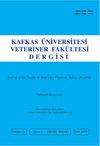Effect of LED Light Color and Stocking Density on Growth Performance, Carcass, and Meat Quality Characteristics of Japanese Quails
IF 0.9
4区 农林科学
Q3 VETERINARY SCIENCES
引用次数: 0
Abstract
This study was conducted to evaluate the effect of LED light color and stocking density on the growth performance, carcass, and breast meat quality characteristics of quails. The experiment comprised 720 1-day-old mixed-sex Japanese quails ( Coturnix coturnix japonica ) randomly divided into 6 experimental groups with 4 replicates in each group. Experimental treatments included three different LED light colors (white, monochromatic blue, and monochromatic green) and two different stocking densities (100 and 200 cm 2 /bird) in a 3x2 factorial design. The feed intake and body weight of quails were measured weekly. At 42 days of age, 20 quails per treatment group were randomly selected for carcass and breast meat quality characteristics analysis. Body weight gain was significantly higher in the blue and green LED light treatments (P<0.05). Quails reared at 200 cm 2 /bird significantly determined the highest body weight gain (P<0.001). Quails reared at 200 cm 2 /bird had the best ratio of feed conversion ratio (P<0.01). Breast meat yield and weight were higher in quails reared at blue LED light. Blue LED light tended to increase the water-holding capacity of breast meat (P<0.01). The breast meat L* value decreased significantly as stocking density (200 cm 2 /bird) increased (P<0.05). However, despite the difference in pH 15 , pH u, and L* value of breast meat, other meat quality characteristics were not different among the stocking density groups. In conclusion, it is shown that mono-crop monochromatic blue or green LED light and 200 cm 2 /bird floor space have a utilization effect on quail performance traits.LED光色和放养密度对日本鹌鹑生长性能、胴体和肉品质的影响
本文章由计算机程序翻译,如有差异,请以英文原文为准。
求助全文
约1分钟内获得全文
求助全文
来源期刊
CiteScore
1.50
自引率
14.30%
发文量
56
审稿时长
3-6 weeks
期刊介绍:
The journal publishes full-length research papers, short communications, preliminary scientific reports, case reports, observations, letters to the editor, and reviews. The scope of the journal includes all aspects of veterinary medicine and animal science.

 求助内容:
求助内容: 应助结果提醒方式:
应助结果提醒方式:


